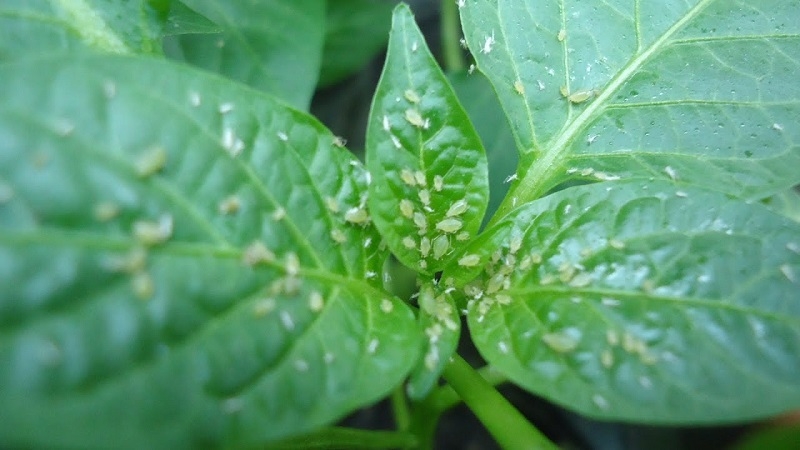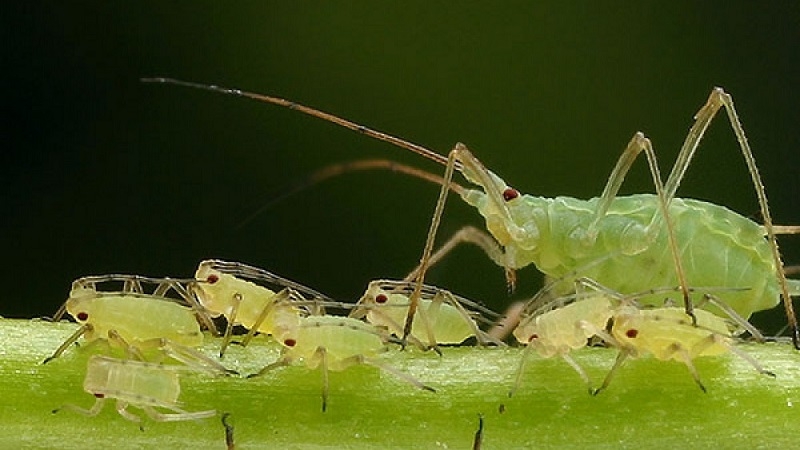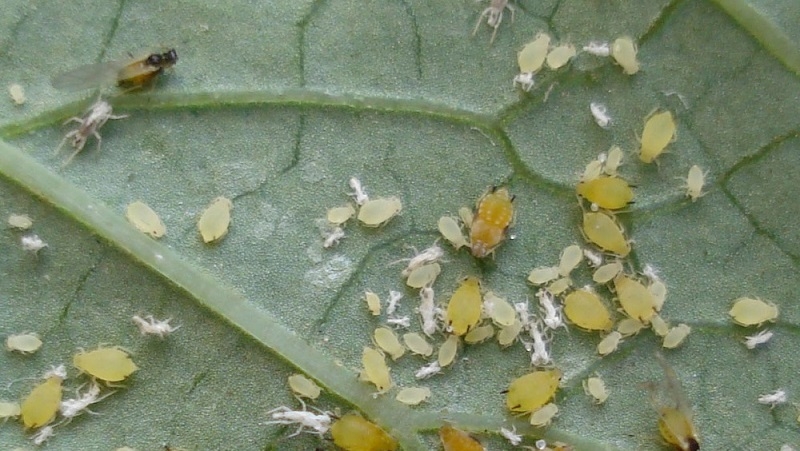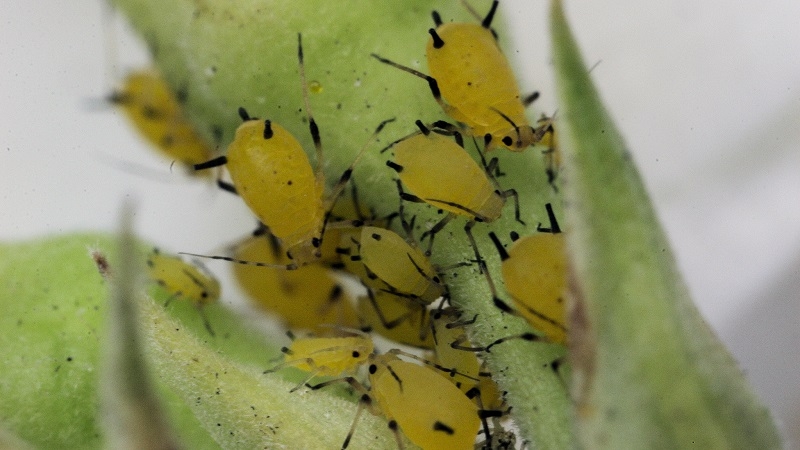Aphids appeared on pepper in the greenhouse: what to do, and how to defeat the pest quickly and efficiently
Aphids are a dangerous, almost invisible pest. Especially in a greenhouse or greenhouse. She is able to very quickly fill the entire territory and destroy the crop. Therefore, it is very important to be able to recognize the presence of insects at the very beginning of their spread and know what to do to get them out of your area. We will analyze the existing methods of protection against aphids and preventive measures for its appearance.
The content of the article
Signs of damage to pepper in a greenhouse aphids
It is difficult to find the insect itself, since the aphid does not exceed 5 mm in size and at the same time has a greenish-transparent color. Thanks to this, it perfectly disguises itself as the green parts of the plantings. There are also darker varieties - from brown to black.
There are a number of signs by which you can determine their presence:
- Stopping the growth of seedlings.
- Curled, yellowed, or blackened leaves.
- Termination of the ovary.
- Deformation of the fruit.
- General weakening of the entire plant.
If you start checking all the plantings, then by turning the leaf plate over, you can find a cluster of aphids in the form of small wiggling greenish or black dots.
Council. Even with the slightest suspicion of the appearance of pests in the garden, it is immediately worth inspecting all the plants. This will allow you to start fighting early with less crop losses.

Harm done
Aphids feed on plant sap. Gnawing the pulp, it sucks out the liquid with all the nutrients necessary for normal growth and vegetable development... Because of this, the plant gradually fades.
But this is not the only problem. As they live, insects secrete a special liquid - pad. It becomes a favorable environment for the development of sooty fungus on the plant, which makes the life of the pepper doubly difficult.
Important! In greenhouse conditions, aphids undergo an incomplete, accelerated development cycle. Females remain wingless. This significantly speeds up the process of reproduction and spread of insects.
Pepper processing rules in the greenhouse
Before you start figuring out how to deal with aphids in a greenhouse, it is worth understanding how it gets there. Aphids are carried with soil, gardening tools, planting material or footwear. Therefore, it is important to regularly disinfect all of the above.
Processing features
In the greenhouse, safety precautions are especially important: gloves, a respirator, closed shoes and clothing. It is better to carry out the treatment on a dry, but not sultry day. Excessive humidity can provoke washing off of drugs from plants.
Biological methods of protection are very effective in the greenhouse. In an enclosed space, introduced predatory insects manifest themselves as efficiently as possible.

Aphid chemicals
Such methods should be resorted to only with a very strong spread of pests and ineffectiveness of folk or biological remedies. Chemical preparations are the most effective, but also the most harmful to humans and the plant itself.
Important! Before using any chemical product, you must carefully read the instructions and strictly follow them, otherwise you can harm the landings even more.
Most popular drugs:
- "Fufanon"effective against most pests. The solution is made from 1 ampoule of the substance and a liter of water.
- "Aktara"intended for processing at an early stage of the growing season. Forces aphids to refuse food, because of which insects die in a day.
- "Karbofos" - a potent drug.Prepared by dissolving a tablespoon of the substance in 10 liters of water.
- "Intavir" affects many garden pests. 1 tablet dissolves in a bucket of water.
- "Actellik" - a preparation of the intestinal contact spectrum of influence. 1 ampoule is designed for 10 sq. m area. Diluted in two liters of water.
Reference. Aphids quickly get used to certain chemicals and develop immunity to them. Therefore, if during processing you made any mistakes and did not manage to get rid of all individuals, it is better to change the tool.

Biological methods of control
The biological method consists in mechanical removal pests... To do this, use insects-predators, birds or independently catch individuals.
To lure birds to your site, you will need to place edible baits for them. Common tits and sparrows do an excellent job of killing aphids.
Among insect predators, ladybirds, some wasps, hoverflies and lacewings are inhabited.
There are also a number of drugs that are sold in specialized stores. They infect pests, rather than kill immediately like chemicals. Biological products do not have a negative effect on plants. The active components in them are the waste products of fungi, bacteria and other microorganisms.
Most Popular:
- "Trichopol";
- Fitoverm;
- "Jaguar";
- Aktofit;
- "Entobacterin";
- "Arrow".

Folk remedies
If the population of pests in the greenhouse is small, it is best to start the fight with the use of folk methods.
Here are some proven ways:
- Plant onions around the outside of the greenhouse and garlic... Their smell scares off aphids. You can stick the garlic heads into the soil along the inside track.
- Dissolve 2 cups of ash and 100 grams of soap solution in a bucket of water. Mix everything, strain and sprinkle with pepper solution.
- Pour 500 g of spruce needles with 2 liters of water and leave for a week. Before use, dilute 40 ml of infusion with a liter of water.
- 1 tbsp. l. soda and 40 g of laundry soap to dissolve in 1 liter of water. Treat the plants immediately after preparing the composition.
- Brew 30 grams of mustard powder with 0.5 liters of water. Insist 3 days. Before use, add enough water to bring the total volume to 10 liters.
- 2 tbsp. l. dissolve ammonia in 10 liters of water with a small amount of soap solution. This solution has a strong effect on aphids, causing convulsions, burns of the mucous membrane and early death.
- A solution of ammonia in the same proportion as ammonia is also very effective.
In addition to the listed substances, vodka, vinegar, celandine have proven themselves quite well in the fight against aphids, tobacco, Birch tar, milk and iodine, boric acid and Coca-Cola.
Reference. Laundry soap is used to improve the adhesion of the substance to the plant. It can be added to all solutions.
Preventive measures
To avoid the appearance of aphids on your beds, you should adhere to the following rules:
- The ideal microclimate in a greenhouse for peppers is 85% humidity and an air temperature of 25 degrees.
- Regular airing.
- Constant feeding.
- Fumigation of the greenhouse with warm sulfur gas prior to planting.
- Disinfection of the greenhouse frame with bleach or potassium permanganate solution.
- Regular weed removal.
- Purchase of planting material only from trusted manufacturers.
Reference. Properly cared for plants have good immunity and are therefore more resistant to pests and various diseases.

Conclusion
Aphids on peppers in a greenhouse can be a gardener's nightmare. Especially if the pest population has already grown strongly. Modern drugs are effective, but some of them can harm the fruit or the owner of the garden. Therefore, prevention is considered an important point in protecting peppers and any other fruit crops from aphids.
By taking care of your plantings and creating ideal conditions for them to grow, you will reduce the risk of aphids on them.And the plants will thank you with a bountiful harvest a little later.